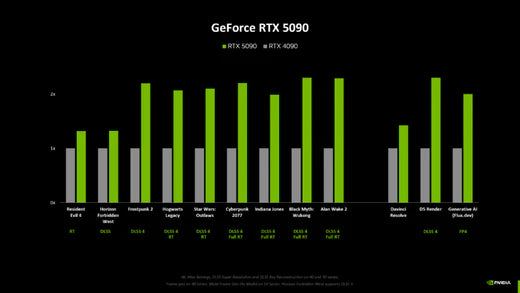
NVIDIA GeForce RTX 50 Series: Significant Performance Boost Over RTX 40 Series
Share
NVIDIA has officially unveiled the impressive new performance benchmarks for the upcoming GeForce RTX 50 series, showcasing substantial performance improvements compared to the previous RTX 40 series. The latest results highlight a significant leap in speed and power, with the new RTX 50 graphics cards offering up to 33% more performance in certain games. These performance figures cover a variety of GPUs, including the RTX 5090, RTX 5080, RTX 5070 Ti, and RTX 5070, and showcase gains in titles like Resident Evil 4 and Horizon Forbidden West. These results are presented without the use of DLSS Multi-Frame Generation (MFG), offering a clear view of the raw power of these GPUs.
Compared to the previous generation, the RTX 50 series offers a noticeable advantage in both gaming and professional applications. The RTX 5090 is leading the charge with up to a 33% boost in ray tracing performance in Resident Evil 4, while other models such as the RTX 5070 Ti and RTX 5070 outperform their RTX 40 series counterparts by up to 20%. These benchmarks underscore the advancement in architecture, shader core count, and overall efficiency. The RTX 50 GPUs are designed to handle even the most demanding games and applications with ease.
Key Performance Highlights Without DLSS MFG:
- RTX 5090 vs RTX 4090: A substantial 33% performance increase, particularly in ray tracing settings like in Resident Evil 4 and Horizon Forbidden West.
- RTX 5080 vs RTX 4080: The RTX 5080 shows a solid performance improvement, offering gains of up to 15% in high-demand games and applications.
- RTX 5070 Ti vs RTX 4070 Ti: A notable 20% increase in performance, particularly in high-performance gaming environments.
- RTX 5070 vs RTX 4070: Performance improvements of about 20%, with enhanced speeds in both ray tracing and traditional rasterization workloads.
This performance uplift is attributed to several key features of the RTX 50 series, including an increase in shader cores and improvements in raster performance. These advancements highlight the efficiency of the RTX 50 GPUs in handling ray tracing, rasterization, and AI-powered features such as DLSS 3. While the benchmarks are presented without DLSS Multi-Frame Generation, which can further enhance the performance in titles that support it, these results are still impressive for gamers and professionals alike.
The RTX 50 series delivers enhanced graphics processing and is expected to set new standards for computer graphics in the coming years. Whether you're looking for a powerful gaming PC or a system capable of tackling complex workloads, these new GPUs are well-suited to meet the demands of modern computing. For gamers and professionals who need the ultimate in performance, the RTX 50 series promises to be the best option.
RTX 50 Series Performance Beyond Expectations
In addition to performance improvements in ray tracing and DLSS, the RTX 50 series will also be beneficial for content creators and gamers looking to take their performance to the next level. With enhanced computer graphics capabilities, the RTX 50 graphics cards are sure to lead the way in both gaming performance and rendering speed. By delivering faster frame rates, smoother gameplay, and more realistic visuals, the RTX 50 GPUs represent the future of high-performance computing.
The RTX 50 series offers performance that outstrips the RTX 40 series in key areas like ray tracing, DLSS 3.0, and multi-tasking. As benchmarks continue to surface and RTX 5090 reviews become available, more insights into the performance of the next-gen GPUs will help cement their place as the top choice for anyone looking for the best in computer repair, gaming, or professional applications.
